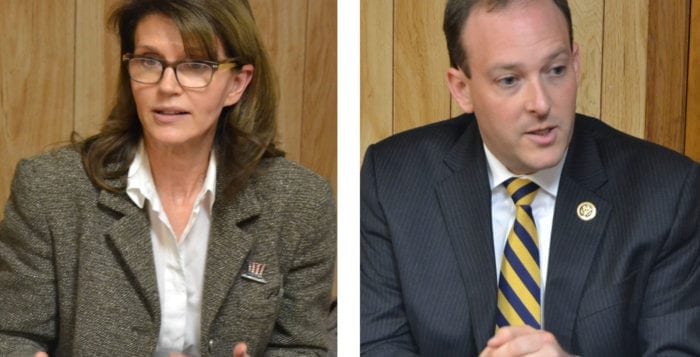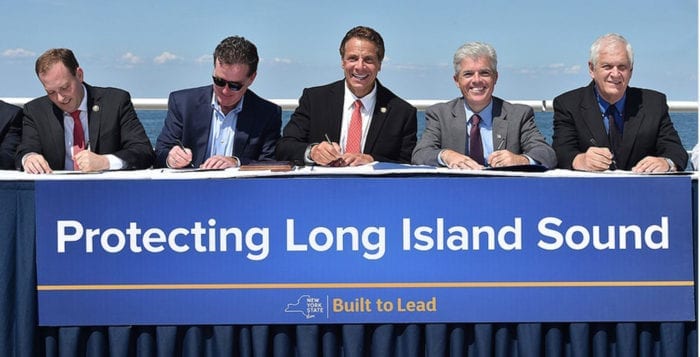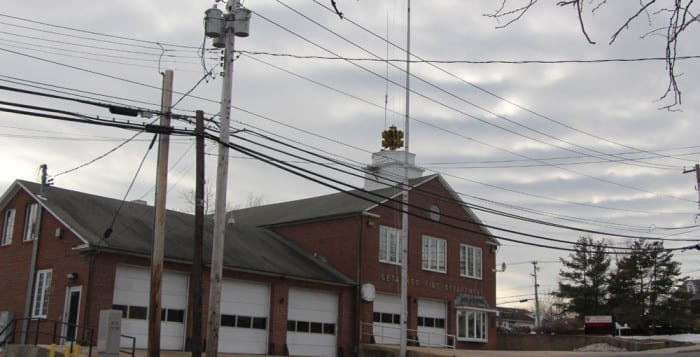By Kevin Redding
A clashing of opinions on almost every issue gave way to a tense debate between an incumbent Republican congressman and a former Southampton Town supervisor as the race for the 1st Congressional District seat enters its final stretch.
Rep. Lee Zeldin (R-Shirley), who graduated from Albany Law School before serving in the U.S. Army Reserve, was first elected into the House of Representatives in 2014 and seeks to maintain that position Nov. 8. He must first win re-election, however, against Democrat Anna Throne-Holst, whose work in local government has been guided by a “people over politics” platform in an effort to make government work for everyone.
The candidates sat down at the TBR News Media office Oct. 27 to square off on a variety of pressing local and national topics, like the environment, veterans issues, Planned Parenthood and the presidential election.
Zeldin has accomplished plenty in his 21 months representing the district, which encompasses most of central and eastern Suffolk County, and takes pride in his willingness to work with absolutely anyone, regardless of party.
“Everyone is entitled to and wants clean air and clean water, and whatever we can do to advance that is important.”
— Lee Zeldin
He has worked hard to help veterans suffering from PTSD, secured the repeal of the saltwater fishing license fee, and fought to block the federal government’s proposed sale of Plum Island.
Throne-Holst has built and run organizations mostly geared toward educational and essential services for families in need of support, worked at the U.N. Department of Peacemaking, and wants to utilize the work she’s done abroad to fix what she calls “thorny foreign policy decisions that we are dealing with.”
She’s committed to providing a service to families and young people in the community who she said have been sorely underserved. She said Congress is at an all-time low approval rating and has not done enough to deal with the critical issues the country is facing.
Before the candidates focused their discussion on the environment, there were accusations from both sides regarding the Environmental Protection Agency.
“All due respect, I think it’s important to note the things where funding has either been slashed or not put forward,” Throne-Holst said. “When I think about things, like the EPA, that he voted to decrease funding for … and the kind of funding that supports programs that are crucial to our residents here in district one New York, and that have been mired in partisan politics in Washington, that is part of what I think is troubling.”
Zeldin refuted Throne-Holst’s statements.
“My opponent repeatedly states that I voted multiple times to defund the EPA,” he said, demanding specific bill numbers from Throne-Holst. “That is not truthful. When there was a vote to cut EPA funding by 17 percent, I voted against the cut. My opponent didn’t read the bill. There are ways to improve the EPA and strengthen the relationship between the EPA and Congress and the American people.”
Zeldin introduced a Long Island Sound Restoration and Stewardship Act alongside Congressman Steve Israel, and said the health of the Sound would be an important issue if he secured another term.
He talked specifically about his involvement in raising money for the National Estuary Program, which provides grants to states threatened by pollution and overuse, and his proposals in relation to Plum Island.
“Everyone is entitled to and wants clean air and clean water, and whatever we can do to advance that is important,” Zeldin said.
Throne-Holst spoke more broadly about the hazards of climate change, an issue Zeldin has questioned the legitimacy of in the past, and sea-level rise. She said there isn’t a single homeowner or business owner in the region immune to climate change. She said the federal government has a responsibility to lead the way in putting together a climate change resiliency plan, district by district.
The debate turned even more contentious when the focus shifted to their respective stances on Planned Parenthood.
Zeldin, who voted for a bill that would halt funding for the organization for a year, was asked whether or not he believed it should be defunded.
“I believe in a woman’s right to choose. I don’t think it’s a question of a personal experience. I think it’s a question of respecting the civil rights of every American.”
— Anna Throne-Holst
“I respect the position amongst American taxpayers who do not want their dollars to go toward funding abortions,” he said. “I certainly have a sensitivity and respect for both sides of this issue … but the idea that it can be legal for someone to be able to decide to get an abortion in the eighth month or ninth month, that is something that I very strongly disagree with.”
When pressed for clarification on the organization’s funding, Zeldin said “as far as funding abortion services, yeah [it should be halted].”
Throne-Holst called their views on the issue a very clear line in the sand.
“I believe in a woman’s right to choose,” she said. “I don’t think it’s a question of a personal experience. I think it’s a question of respecting the civil rights of every American. The idea that government has any role to play in making that decision for anyone goes against any provision of humanity.”
Zeldin has publicly supported Republican nominee Donald Trump in the race for the White House in the past, though he said we have two flawed options for president, referring to Democratic nominee Hillary Clinton as well. He offered no defense for Trump’s well-documented controversial statements, including the Access Hollywood leak wherein Trump boasted about sexually assaulting women.
He said he sides with Trump on many issues, like improving foreign, tax and immigration policies and defeating “Islamic Extremism.” He said he agrees with Trump more than he agrees with Clinton.
Throne-Holst accused her opponent of going on CNN numerous times to defend Trump in the past. She said there is no excuse for overlooking the statements Trump has made and “allowing this man to be the supreme leader of this country and be the role model for our children.”








